
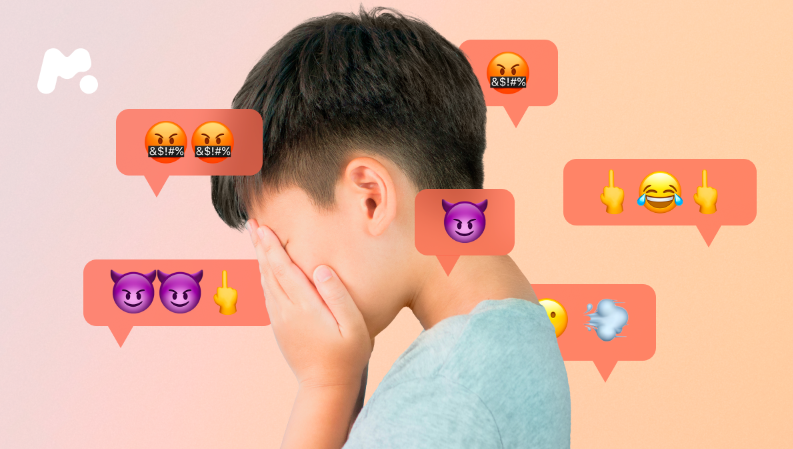
November is Bullying Prevention Month. But at mSpy, we think every day should be about bullying prevention. With a focus on anti-bullying behavior among children and teens, we have several teams dedicated to figuring out how to prevent bullying through smart technology.
Today, we’re going to dedicate some time to help you understand the different types of bullying, the extreme dangers bullying poses, and how to do your best to tackle bullying head on should you find out that your child is a victim.
Table Of Contents
Bullying Statistics Every Parent Should Know
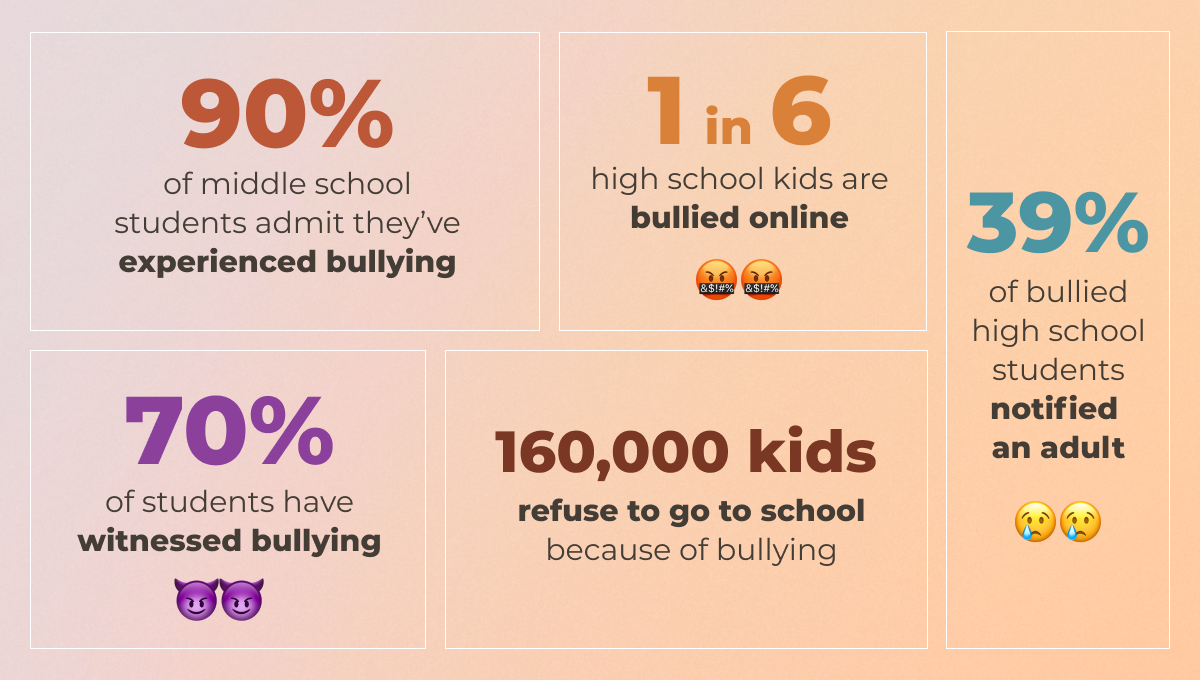
- 90% of students in 4th to 8th grade admit they’ve experienced bullying
- 1 in 6 high school kids reports being bullied online.
- Only 39% of high school students notified an adult of bullying
- 70% of students have witnessed bullying
- Over 160,000 kids refuse to go to school each day because of bullying
Types of Bullying
Physical bullying. Any type of bullying that involves a physical altercation is classified as physical bullying. While this includes hitting, kicking, or tripping someone, it also includes the destruction of someone’s property — like throwing someone’s school bags in the garbage.
Verbal bullying. This type of bullying happens in the real world and online. It includes yelling insults at someone. It includes making fun of someone to their face or even behind their back. It includes calling someone ugly. Or fat. Or smelly. Anything really.
Social bullying. This is one of the signs of bullying that can be harder to identify, but it’s just as damaging. Social bullying can include spreading rumors, mimicking someone negatively, playing jokes on them, or just making them feel like an outsider.
Signs of Bullying
Is my child being bullied? That’s a question parents constantly ask themselves. And for a good reason. With the prevalence of bullying on social media, it’s easy for any kid to become a target. That’s why it’s helpful to know what to look for.
If your child exhibits any of these bullying signs, it’s time to step in. Some signs could be an indication of something else — perhaps a medical issue. That’s why it’s important to talk to a healthcare professional if something doesn’t seem right.
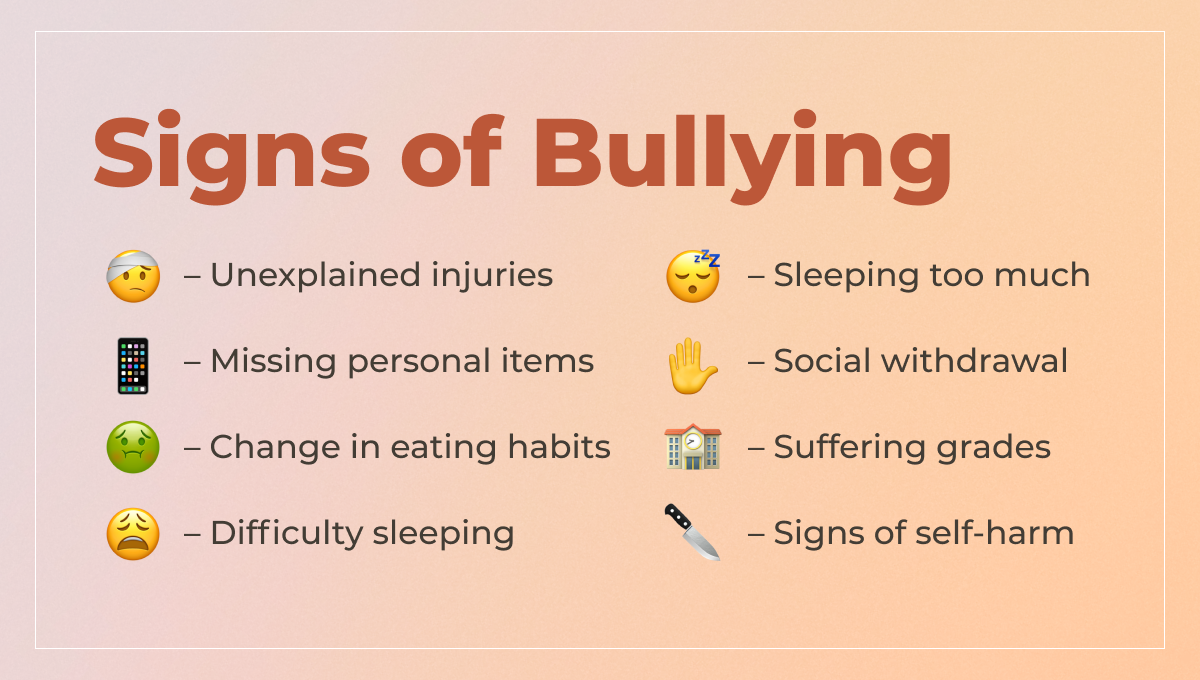
Unexplained injuries. You’ve done everything in your power to figure out how to prevent bullying, but they’re coming home with bruises on their arms, scratched knees, or cuts on their face. Sure, some of these injuries could be attributed to an accident on the football field, but if it’s happening frequently, there’s a chance they’re being bullied in the real world.
Missing personal items. Are they no longer in possession of some of their favorite things? Their phone? Their watch? Some jewelry? A book? It’s possible that they’re being bullied and someone’s forcing them to surrender their personal belongings.
Change in eating habits. Not wanting to eat is one of the biggest signs my child is being bullied. And so is constant binging on food. We know what you’re thinking. These two signs of bullying are complete opposites, so how can I know? Well, consider any sudden change in eating habits problematic. It could be a sign of bullying, or it could be some sort of other health or mental health issue. Either way, it needs attention.
Difficulty sleeping. Is something keeping them up at night? Or are they frequently waking up for no reason in the middle of the night? The anxiety could be getting to them. And that’s when you need to step back and realize, “OK, my child is being bullied” and take action.
Sleeping too much. If they’re constantly tired or prefer to take naps regularly, this could be a sign that they’re a bullying victim. Sure, teenagers often sleep in, but if their patterns suddenly change, it’s worth looking into.
Social withdrawal. Do they suddenly prefer to stay home instead of socializing with friends? Are they much happier staring at the TV than engaging with their friends after school or on weekends? Any type of withdrawal from social activities that seems sudden or out of the norm should be investigated.
Suffering grades. How do I know if my child is being bullied? Well, if they’ve been getting high marks in school and their grades suddenly drop without warning, there’s a chance they’re being bullied. Whether in person or online, bullying affects a child’s mental health, which ultimately can affect their level of focus. When focus suffers, grades drop.
Signs of self-harm. If they’re exhibiting signs of self-harm like cutting, or if there’s any indication of suicidal thoughts, bullying might be involved. While you should take action and get help if you notice any of the above signs of bullying, it’s especially crucial to do so if your child wants to harm themselves — or worse.
What to Do If You Find Out Your Child Is Being Bullied
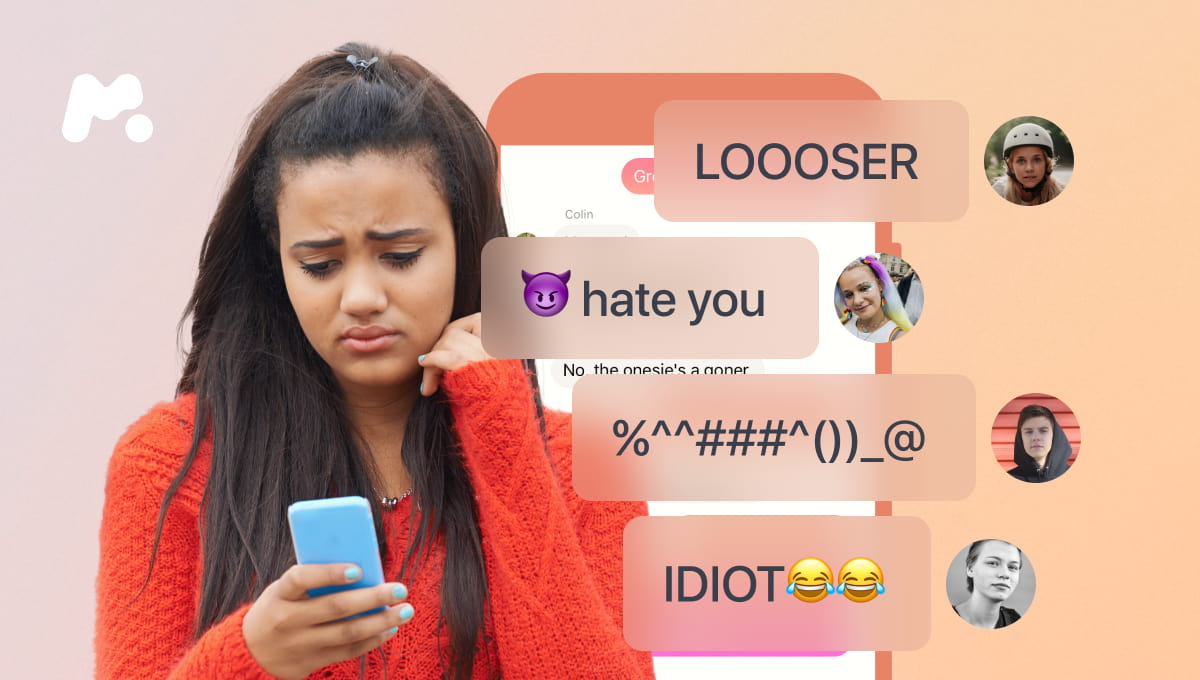
Now that you know how to recognize bullying, it’s important for your child to know what to do if they become a victim of online bullying. By having conversations with them in advance, they’ll be prepared to do something about it and hopefully stop bullying in its tracks before it gets out of hand.
Take a breather
Tell your child to walk away from their phone if they see signs of bullying directed at them. We aren’t suggesting your child completely ignore the fact that they’re being bullied, but walking away from the situation, even for a moment, is always a wise idea.
Don’t respond or retaliate
If someone throws a punch, the first instinct might be to fight back. But when online bullying occurs, it’s important to not retaliate or even respond right away. There are all kinds of different bullying types and each one requires a tailored response.
It’s important to take a step back and figure out how to handle the situation before doing anything rash. The last thing you want is for your child to respond to bullying by becoming the bully themselves.
Take screenshots of any bullying messages
If the bullying is blatantly obvious, have your child take screenshots of the situation. Your child should not share these screenshots with others. That’s not a great bullying prevention tactic.
But what your child should do is save those screenshots in their photo library. You never know when they might need it as evidence when the time comes to deal with the bully.
Report them in the app
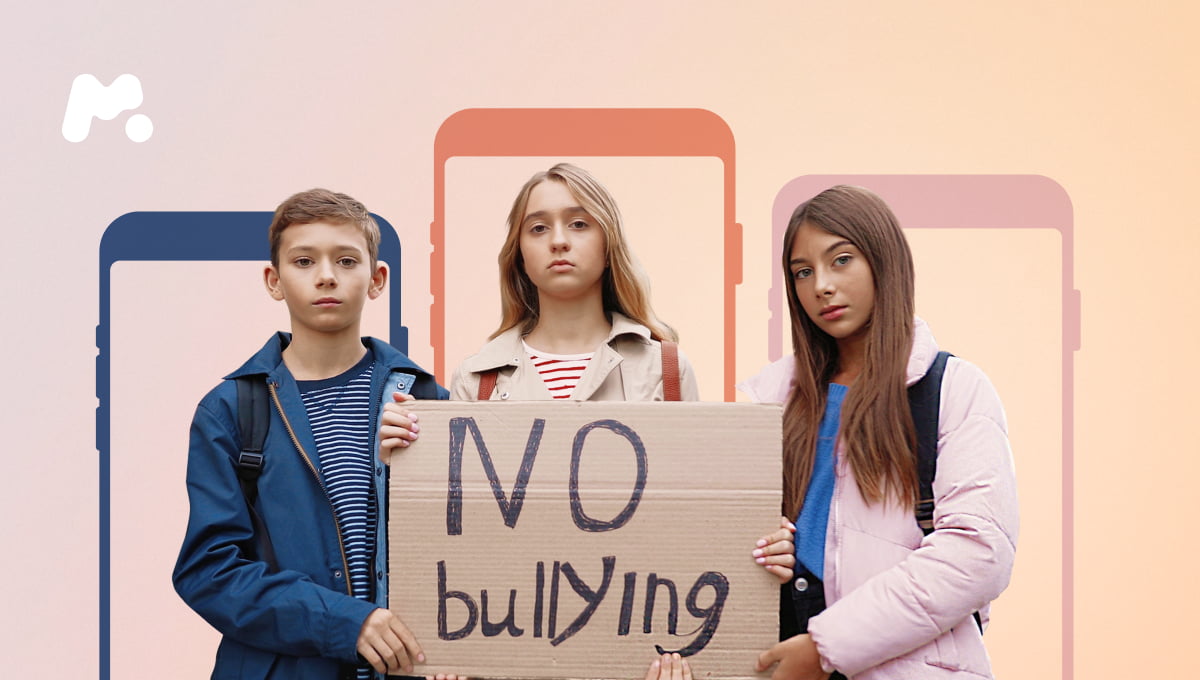
Social media apps tend to breed bullying. And the people behind these social networks understand that. That’s why many of them have mechanisms in place to help people report bullying behavior.
Once reported, the site will investigate the bullying signs and decide on a course of action. That could mean suspending the user from using social media for set period of time (an hour…a week…a month) or it could mean banning the user from that social media site for life.
Talk to a trusted adult
Kids often feel alone when they’re being bullied. And they often feel like there just aren’t ways to prevent bullying. It’s important to let your kids know that they’re never alone. They can always talk to you about bullying.
And kids aren’t comfortable talking to you about it, encourage them to find a trusted adult who they’re comfortable with. That could be the bully’s parents, a teacher, a principal, a sports coach, or anyone else.
The majority of adults do not stand for different types of bullying, and they’re always willing to help solve any abusive behavior before it escalates.
How to Prevent Bullying
Encourage positive behavior
Knowing your kid is being bullied is scary. But knowing that your kid is the one doing the bullying? That can be just as frightening. That’s why it’s important to encourage positive behavior among kids early in their life. Kids look up to their parents and learn from them.
Be nice to the grocery store clerk and your kids will learn that respect goes a long way. Say thank you to the bus driver when leaving the bus. Remember, it’s the little things. Witnessing small gestures can help shape a how a child views others and ultimately aid in bullying prevention.
Get a monitoring app like mSpy
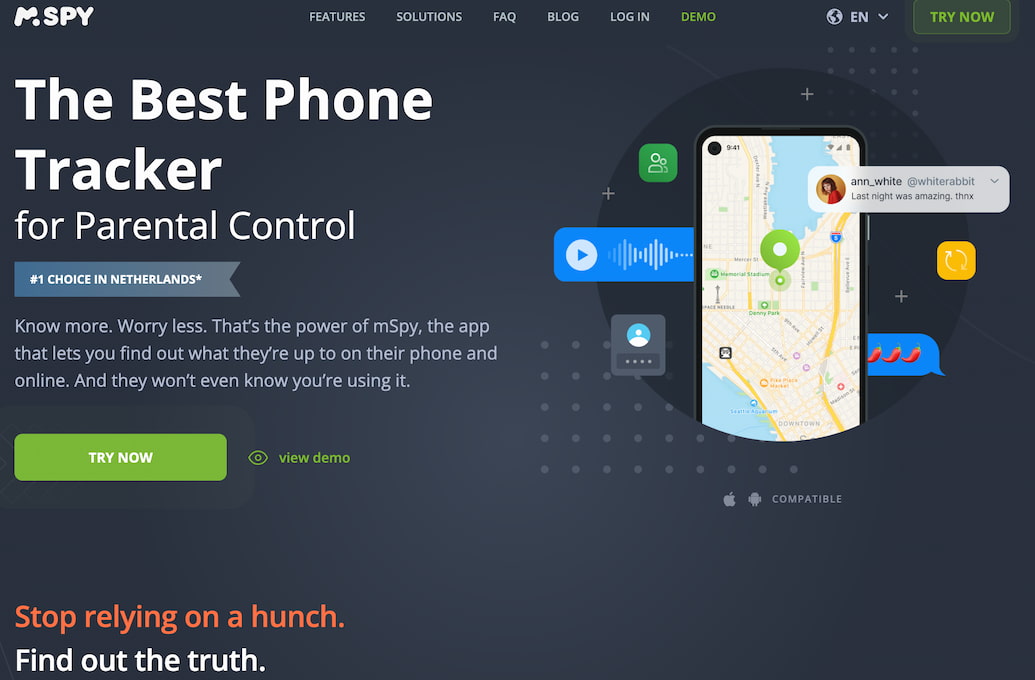
One of the best ways to prevent bullying is to detect it early. And an app like mSpy can help. The monitoring app includes several features to help parents identify bullying and stop it in its tracks before it gets out of control. Here’s what mSpy can do.
- Detect bullying in social media chats and texts. mSpy lets you read their private chats on social media apps like Messenger, Instagram, WhatsApp, and Snapchat — all social networks where bullying can run rampant. You can also read their texts, emails, and more. If you noticed bullying behavior in their communications, you’ll be able to address it head on.
- Alert you to possible bullying. You can’t always be on top of them. And you don’t have the time to constantly scroll through their conversations. That’s OK. mSpy keeps tabs on their chats or search history and alerts you if any keywords or phrases are used. For example, if you set “kill yourself” as a keyword, mSpy can let you know if those words are used on their phone.
- Show you their search history. Are they searching for ways to stop bullying? Or looking to get help? Or looking for a way out? Their search history can offer clues. And mSpy gives you the power to see what they’ve been searching for.
- Give you the power to see everything. It’s not just about knowing how to recognize bullying. It’s about being able to see the signs of bullying without being seen. Thankfully, mSpy works in hidden mode, so they won’t know you’re reading their conversations or looking at their phone.
Save 45% on mSpy for Bullying Prevention Month
We want to do everything in our power to help prevent bullying and help parents feel better about what their kids are up to online. That’s why we’re offering you a discount on mSpy when you purchase it in November.
No matter what device they own, mSpy is designed to work perfectly and undetected. While it can’t prevent bullying entirely, it can help you detect it early and hopefully put a stop to it.





